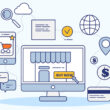2021 was a record year for data breaches in the U.S., with 1,862 total—68% higher than the number of breaches in 2020. But cybercrime isn’t just booming, it’s continuously evolving.
Cybercriminals and malicious actors are constantly changing their hacking strategies to get information, so it’s more critical now than ever to protect your data from powerful threats.
We’ve outlined the best technologies and strategies to protect your customers’ safety.
What is the official definition of customer data privacy?
Customer data privacy and its safeguarding entail the crafting of policies and processes that:
1. Ensure that data is collected legally and ethically.
2. Define how data is collected and shared with third parties, and:
3. Create regulations and restrictions around the handling of data and information.
Why it’s important to protect customer data privacy
Your customers trust you to keep their information away from bad actors, and it’s your legal and moral right to do so. If exposed to a data breach, your customers’ data can be used to steal their account access, money, identity, and more. This could have disastrous financial consequences for both them and you—on average, data breaches cost 4.24 million dollars to resolve. Not to mention your reputation and brand image may suffer for weeks, months, or even years following.
Use password management tools
Password management tools use encryption to store each password making it easier to store sensitive data. That way, when someone needs to log in to a tool that has sensitive customer data, they can easily pull the login information from the password manager. With this you avoid the risk and effort to type it manually, save it to a browser, on notes, or any physical piece of paper – all of which are more insecure methods of saving passwords).
Good password management tools use complex encryption for the passwords they store. This makes the password unreadable to anyone without the encryption key, thus keeping your customers’ data safer from rising cybercrime.
Secure your wifi network and passwords
If operating out of an office or other physical space, it’s safety-critical that you have your own private WiFi network, with separate options for employees and guests. A private WiFi network requires a password to connect, whereas public or open networks can be accessed by anyone. Opt for WPA2 (wireless protected access 2) security protocols, when setting up, as this offers encryption and requires longer passwords.
You should also change the password to your WiFI network often, making sure that any passwords guarding data are long and complex–with symbols, numbers, and capital letters–and updated every 90 days or so. You might also consider implementing multi-factor authentication at critical points for extra safekeeping.
Implement two-factor authentication
Two-factor authentication, also known as 2FA, can make your customers’ data safer in more ways than one. Similar to implementing a password manager, you can also mandate the use of an authentication app, such as Okta or OneLogin, while your employees log in to programs that contain customer data. That way, you can feel more at ease about allowing remote access without compromising customer safety.
If you offer a software product, you should strongly consider building 2FA into your product roadmap if it’s not there already.
The extra layer of security with 2FA helps reduce fraud, unauthorized access, and much more. Companies can be more confident about allowing remote access for their employees, and customers can feel confident that their data is secure.
Flexible identity authentication
In addition to implementing 2FA, flexible identity authentication (FIA) protects sensitive company and customer data because it requires double authentication. Organizations can enhance their security and improve customer experience with best-in-class authentication and adaptive access control.
FIA works by requiring your employees to generate a one-time password (OTP) using a PIN code and an authenticator, which could be a physical token, additional software, an SMS message, or a grid. This system makes it much more difficult for malicious actors to login to your systems.
Encrypt your emails
Email encryption helps to ensure that your emails—and the vital business information they contain—will be read-only by intended recipients. Modern email encryption solutions are easy to use and seamlessly integrate into commonly used email platforms.
Consider using a service that also continually scans for suspicious emails and stops them from landing in your inbox. This prevents you or your team members from inadvertently opening or clicking on anything potentially harmful.
As another precaution, you can set your devices to manually load images and attachments within emails. This will help stop you and your teams from loading harmful attachments on your device that could compromise your sensitive data.
Set minimum security standards
Not all tools are created equal when it comes to security. Make sure any tool you use complies with either SOC 2 or ISO 27001. Both of these standards require companies that comply with them to continuously monitor and upgrade their data security protocols.
Some companies choose to proudly display their compliance information on their website, but you may need to contact your tools’ account managers or another point of contact to verify their compliance.
Create firm rules for how data can be accessed
Don’t get in the way of your customers’ safety by not establishing firm rules and protocols for how data is accessed. For example, limiting access to certain data will minimize the points of vulnerability for your organization. The fewer points of access to your data, the more secure it will be.
You should also give them visibility into what and where these sensitive data exist. This will keep them aware of the location and cautious while handling certain programs or files.
Another great way to limit access to customer data is to implement a program request form. Instead of giving complete access rights to every employee, you can create a request form ensuring they have the limited and necessary access to do fulfill their jobs. When the situation demands more access or different data sources, all they need to do is present another form to the IT team to grant access.
Use a firewall to protect personally identifiable information
Personally Identifiable Information (PII) should be treated as the most critical data in the organization. This includes but is not limited to:
- Bank account information
- Credit card numbers
- Social security numbers
- Passport or driver’s license numbers
- Biometric records
- Street addresses
- Personal phone numbers
- Personal email addresses
- IP addresses
- Fingerprints
- Handwriting
To prevent your customers from being victims of identity theft or other harmful acts, systems storing these types of datasets should always be behind a firewall. This filters traffic and prevents unauthorized users from gaining access to valuable data. The data should also be encrypted at rest and in transit.
PII data also needs to comply with international and local privacy laws including GDPR and CCPA. The fields can be anonymized or pseudonymized to partially achieve that, making customer data more secure.
Keep systems and software up-to-date
Security patches and updates protect your system from harmful malware and ransomware. To combat the risk of a data breach, it’s best to ensure your operating systems, antivirus software, and other programs are up-to-date. An IT risks survey conducted in June 2020 found that 65% of companies that used outdated software suffered breaches.
Set a time of the week to update all your systems when there are new versions available. Scheduling this activity each week makes it a habit and enables you to protect data on a regular basis.
Encourage use of a VPN if necessary
Flexible and hybrid work arrangements are now more of a norm than ever. If your employees need to access the company server while using any kind of public wifi, such as in a cafe or co-working space, make sure they use a VPN (Virtual Private Network). They create a secure browsing experience so that no one can see your data and activity, regardless of the network you’re connected to.
In addition to masking your online activity, certain VPNs monitor the dark web on your behalf and notify you if your information was exposed in a data leak.
Adopt a Secure Access Service Edge (SASE) model
By 2024, it is estimated that at least 40% of enterprise businesses will be looking to adopt SASE. SASE is a security framework that combines SD-WAN and VPN capabilities.
By setting up SASE, companies can detect and prevent cloud and web attacks such as cloud phishing, malware, ransomware, and malicious insiders, regardless of the employees’ numbers, their location, and how many systems are used on daily basis. This makes it ideal for growing businesses that are looking to structure their networks in such a way that prioritizes both safety and flexibility.
SASE services range from firewalls and secure web gateways to cloud access security brokers, DNS security solutions, and beyond.
Invest in Software-defined Wide Area Networks (SD-WANs)
SD-WANs are a type of network architecture that enterprise organizations use to securely connect users to their applications. Traditional network connections weren’t designed to handle cloud-based software and therefore can slow down productivity. SD-WANs was designed to remedy this by providing what’s known as intelligent application-aware routing. This means that each application will automatically receive the appropriate security enforcement when accessed.
Putting security functions in an SD-WAN will give remote users direct access to cloud services, whether those are on-premise or external. Your organization will get faster connectivity and better user experience while still getting the identity-centric protection it needs.
Implement data encryption and tokenization
Using encryption and other obfuscation techniques to obscure data within databases as well as in big data platforms will protect personal privacy, achieve necessary industry compliance, and minimize the impact of cyberattacks and accidental data leaks. When data is encrypted, it will have extra protection while traveling and can only be unlocked at the endpoint with the decryption key.
However, using encryption means carefully walking the line between privacy and ease of use. Many organizations are now turning to homomorphic encryption, which allows calculations on data in its encrypted state. This can up your organization’s productivity while still keeping your data safe.
Along with encryption, tokenization can help disguise sensitive customer information. Tokenization works by substituting a randomly generated value, known as the token, for sensitive data such as credit card numbers, bank account numbers, and social security numbers. Since they are randomized values, tokens cannot be used to obtain someone’s personal data on their own. This lets companies use the data to do business as usual without compromising on security.
Choose cloud software over saving locally
Information stored in cloud-based software is much more likely to be safeguarded than if stored on your local device. This is because cloud applications rely on more intense cybersecurity measures to protect your data than say, a hard drive.
For example, if your business uses a customer care call center, an on-premises PBX is much more difficult and costly to update, and more susceptible to Internet-related attacks, jeopardizing your customers’ safety and your flow of business. In contrast, a cloud PBX is much easier to keep up-to-date, and stores your data much more reliably and securely.
Backup any critical data
When a computer or server is attacked by hackers, the likelihood of your data being compromised is very high. This would require you to reinstall some of your systems in order to maintain the integrity of your device. If you have not previously backed up your critical data, there’s a less likely chance of data recovery.
While cloud software is a huge boon to our productivity, it’s a smart idea to also back up your files on at least two physical storage devices. Just be sure to store these devices in a secure location.
Use software that’s aligned with the compliance regulations within your industry
Most organizations collect personally identifiable information, such as names, addresses, phone numbers, and passwords from customers. Some may even collect far more sensitive information, such as credit card numbers, social security numbers, and license information.
Collecting such sensitive data plays into many different industry regulations and compliance standards. Notable examples include HIPAA, GDPR, WCAG, and PCI.
Many industry regulations have strict guidelines on how to appropriately collect, secure, or share sensitive data. If your organization is found non-compliant with the regulations that mandate data protection within your industry, you could face large fines and other repercussions.
If you’re not sure that your company’s practices are 100% compliant with the industry standard, you may need to perform an audit to check for any potential shortcomings. You can either do it manually or employ an outside consultant or use software to detect the non-compliance issues.
Get employee monitoring software to monitor potential threats
While unfortunately, you can’t control every aspect of your business operations, you can still keep an eye out to stop security threats before they get worse. Employee monitoring software can be deployed on enterprise systems and in remote workplace settings. With this, businesses can track employees’ habits and are alerted when something atypical happens.
This type of software also gives employers a birds-eye-view into their employees’ workdays. View a remote computer screen to check if your employee is actually working, or if a malicious actor has gotten onto their work computer. Or, read through your employees’ messages to see if they are planning any sort of attack from the inside.
Conclusion
There’s no denying that your customers’ data should be stored as safely as possible. One bad data breach may cause irreparable damage to your customer’s sensitive information and your company’s reputation.
By following the steps in this article, you’ll be well on your way to making your customer data more secure against impending cybercrime and digital threats.









